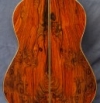Using the right hand - Free Strokes
[right hand finger name image] The right hand fingers and thumb are named, the origins are spanish. You will often see i, m, a or p on guitar music, this tells you which right hand finger to use.
- Indice, meaning index finger. 'i'
- Medio, meaning middle finger. 'm'
- Anular, meaning ring finger. 'a'
- Pulgar, meaning thumb. 'p'
We still call the ring finger 'Anular' but it is usual to refer to the thumb, first and second fingers as 'thumb', 'index' and 'middle'.
How to do it:
[right hand freestroke image] Curl your fingers slightly but keep your hand relaxed. Touch your fingers against the strings. Your index finger should be touching the third string, middle finger touching the second string and anular finger touching the first string. Let your thumb rest on the fourth string. It is particularly important that you keep your thumb straight, away from your fingers, or your thumb and fingers will crash into each other when playing. If you have trouble with this, make a loose 'thumbs up' sign before placing your fingers on the strings. Now adjust your hand position so you can keep this shape with thumb and fingers in contact with the strings.
Make sure your fingers are not curling under the strings. We do not want to pull the strings away from the guitar or they can slap against the fretboard, making a particularly unpleasant sound. The fingers (and thumb) should be lightly touching their adopted strings.
Now press down lightly with your index finger and scratch the string. Allow the finger to curl ever so slightly, so it does not touch the next string. The finger should then spring back over the original string, ready to play again. All the movement should be from the finger, do not let your hand pull away from the guitar strings. When your finger returns, the string will stop ringing. We will eventually want the notes to ring for their full value, but to begin with it is better to keep the notes short so your fingers are resting on their strings, ready to play again.
Your hand must be relaxed at all times. It is a very gentle movement and there is no need to tense the hand as your fingers move.
The Exercises
Middle finger hop, First finger hop and Thumb drum give you the chance to get used to the freestroke technique and to get used to reading notes and rhythms. Remember that your posture and right hand technique are really important! Make sure your thumb and fingers are resting on their home strings when not in use.
Now turn the page and play Camel Trail, Leapfrog, The Station Clock and The Military Clock. Again, make sure your fingers return to the correct strings after playing. Make sure your thumb is not in line with your index finger or you will have problems moving them properly.

